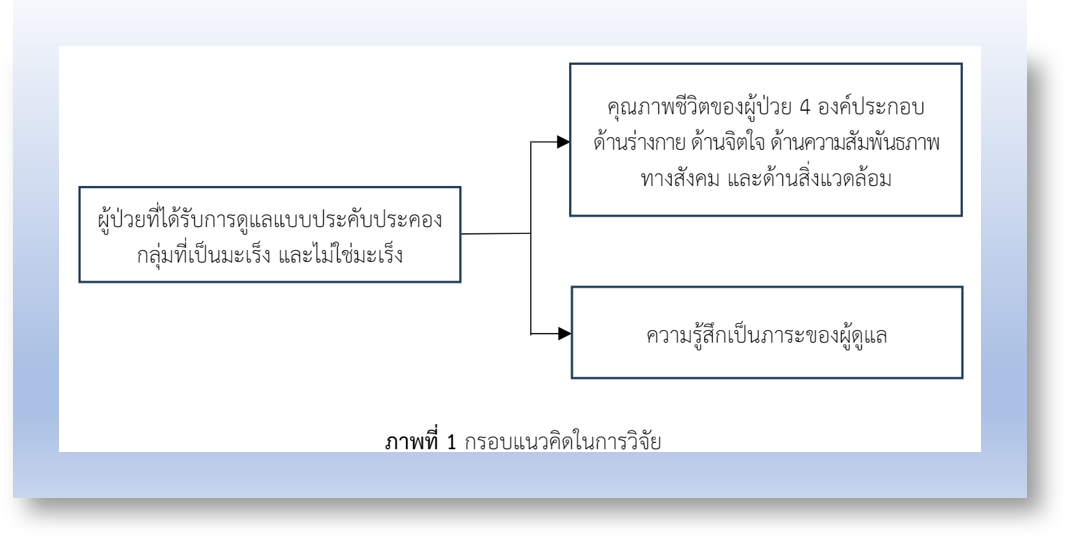คุณภาพชีวิตของผู้ป่วยและความรู้สึกเป็นภาระของผู้ดูแลผู้ป่วยที่ได้รับการดูแลแบบประคับประคองที่เป็นมะเร็งและไม่ใช่มะเร็ง ในชุมชนพื้นที่เขตหลักสี่ กรุงเทพมหานคร
คำสำคัญ:
การดูแลแบบประคับประคอง, ผู้ป่วยมะเร็ง, ผู้ป่วยที่ไม่ใช่มะเร็ง, คุณภาพชีวิต, ความรู้สึกเป็นภาระของผู้ดูแลบทคัดย่อ
การวิจัยเชิงพรรณนาแบบภาคตัดขวางครั้งนี้ มีวัตถุประสงค์เพื่อศึกษาเปรียบเทียบคุณภาพชีวิตของผู้ได้รับการดูแลแบบประคับประคองกลุ่มที่เป็นมะเร็งและไม่ใช่มะเร็ง จำนวน 53 ราย และเปรียบเทียบความรู้สึกเป็นภาระของผู้ดูแลจำนวน 53 ราย ในชุมชนเขตหลักสี่ กรุงเทพมหานคร กลุ่มตัวอย่างคัดเลือกแบบเฉพาะเจาะจง เครื่องมือที่ใช้รวบรวมข้อมูล ได้แก่ แบบสอบถามข้อมูลทั่วไป แบบสอบถามคุณภาพชีวิตฉบับย่อ และแบบสอบถามภาระของผู้ดูแล ทดสอบความเชื่อมั่นด้วยค่าสัมประสิทธิ์แอลฟาของครอนบาค เท่ากับ .94 และ .77 ตามลำดับ วิเคราะห์โดยใช้สถิติเชิงพรรณนา และสถิติทดสอบแมนวิทนีย์ยู
ผลการศึกษา พบว่า คุณภาพชีวิตผู้ป่วยที่ได้รับการดูแลแบบประคับประคอง จำนวน 53 ราย ทั้งผู้ป่วยมะเร็งและไม่ใช่มะเร็งอยู่ระดับปานกลาง (Median = 75.00, IQR = 26 และ Median = 87.50, IQR = 44) เมื่อวิเคราะห์รายด้าน พบว่า คุณภาพชีวิตด้านร่างกายของผู้ป่วยมะเร็งและไม่ใช่มะเร็งมีความแตกต่างกันอย่างมีนัยสำคัญทางสถิติ (p-value < .05) นอกจากนี้ ความรู้สึกมีภาระของผู้ดูแลผู้ป่วยมะเร็งและไม่ใช่มะเร็งอยู่ในระดับปานกลางถึงมาก (Median = 45.00, IQR = 17 และ Median = 54.00, IQR = 21) มีความแตกต่างกันอย่างมีนัยสำคัญทางสถิติ (p-value < .05) ผลการวิจัยนี้ สามารถเป็นข้อมูลพื้นฐานสำหรับบุคลากรที่ดูแลแบบประคับประคองในการส่งเสริมคุณภาพชีวิต และช่วยลดภาระของผู้ดูแลให้ครอบคลุม ทั้งผู้ป่วยกลุ่มมะเร็งและไม่ใช่มะเร็ง
เอกสารอ้างอิง
Worldwide Hospice Pallaitve Care Alliance. Global atlas of palliative care [Internet]. 2020 [cited 2023 Dec 20]. Available from: https://cdn.who.int/media/docs/default-source/integrated-health-services-(ihs)/csy/palliative-care/whpca_global_atlas_p5_digital_final.pdf?sfvrsn=1b54423a_3
Wu LF, Lin C, Hung YC, Chang LF, Ho CL, Pan HH. Effectiveness of palliative care consultation service on caregiver burden over time between terminally ill cancer and non-cancer family caregivers. Support Care Cancer 2020;28(12):6045-55. doi: 10.1007/s00520-020-05449-2.
Wiblin L. An introduction to neuropalliative care: a growing need. Clinical Medicine (London, England). 2024;24(2):100038. doi: 10.1016/j.clinme.2024.100038.
Freire MEM, da Costa SFG, de Lima RAG, Sawada NO. Health-related quality of life of patients with cancer in palliative care. Texto and Contexto-Enfermagem 2018;27(2):e5420016. doi: 10.1590/0104-070720180005420016.
Chu WM, Tsai HB, Chen YC, Hung KY, Cheng SY, Lin CP. Palliative care for adult patients undergoing hemodialysis in Asia: challenges and opportunities. Journal of Hospice and Palliative Care 2024;27(1):1-10. doi: 10.14475/jhpc.2024.27.1.1.
Puengsook W, Kanthawee P, Markmee P. The factors influencing to the quality of life of cancer patients in the end of life care in Chiang Rai province. Thai Journal of Health Education 2020;43(1):143-54. (in Thai)
Pop RS, Puia A, Mosoiu D. Factors influencing the quality of life of the primary caregiver of a palliative patient: narrative review. Journal of Palliative Medicine 2022;25(5):813-29. doi: 10.1089/jpm.2021.0322.
Bostwick D, Wolf S, Samsa G, Bull J, Taylor DH, Johnson KS, et al. Comparing the palliative care needs of those with cancer to those with common non-cancer serious illness. Journal of Pain and Symptom Management 2017;53(6):1079-84.e1. doi: 10.1016/j.jpainsymman.2017.02.014.
Supaporn K, Isaramalai Sa, Khaw T. Family caregivers’ perceptions of caring for older persons in the palliative care stage at home. Pacific Rim International Journal of Nursing Research 2022;26(1):161-74.
Ahmad Zubaidi ZS, Ariffin F, Oun CTC, Katiman D. Caregiver burden among informal caregivers in the largest specialized palliative care unit in Malaysia: a cross sectional study. BMC Palliative Care 2020;19(1):1-15. doi: 10.1186/s12904-020-00691-1.
Perpina-Galvan J, Orts-Beneito N, Fernandez-Alcantara M, Garcia-Sanjuan S, Garcia-Caro MP, Cabanero-Martinez MJ. Level of burden and health-related quality of life in caregivers of palliative care patients. International Journal of Environmental Research and Public Health 2019;16(23):4806. doi: 10.3390/ijerph16234806.
Mounsey L, Ferres M, Eastman P. Palliative care for the patient without cancer. Australian Journal of General Practice 2018;47(11):765-9. doi: 10.31128/AJGP-07-18-4625.
Pereira-Morales AJ, Valencia LE, Rojas L. Impact of the caregiver burden on the effectiveness of a home-based palliative care program: a mediation analysis. Palliative and Supportive Care 2020;18(3):332-8. doi: 10.1017/S1478951519000749.
Zhang Y, Li J, Zhang Y, Chen C, Guan C, Zhou L, et al. Mediating effect of social support between caregiver burden and quality of life among family caregivers of cancer patients in palliative care units. European Journal of Oncology Nursing 2024;68:102509. doi: 10.1016/j.ejon.2024.102509.
Yi M, Jiang D, Jia Y, Xu W, Wang H, Li Y, et al. Impact of caregiving burden on quality of life of caregivers of COPD patients: the chain mediating role of social support and negative coping styles. International Journal of Chronic Obstructive Pulmonary Disease 2021;16:2245-55. doi: 10.2147/COPD.S311772.
Carrasco-Zafra MI, Gomez-Garcia R, Ocana-Riola R, Martin-Rosello ML, Blanco-Reina E. Level of palliative care complexity in advanced cancer patients: a multinomial logistic analysis. Journal of Clinical Medicine 2020;9(6):1960. doi: 10.3390/jcm9061960.
World Health Organization. Programme on mental health : WHOQOL user manual, 2012 revision [Internet]. 2012 [cited 2023 Jul 20]. Available from: https://iris.who.int/handle/10665/77932
Department of Mental Health. WHOQOL-BREF Thai [Internet]. 2002 [cited 2023 Jan 15]. Available from: https://dmh.go.th/test/download/files/whoqol.pdf (in Thai)
Pankong O, Kangchai W, Subgranonth R. Effects of self-help group on perceived burden and well-being of caregivers of the elderly with dementia. The Journal of Faculty of Nursing Burapha University 2006;14(1):47-57. (in Thai)
Lee GJ, Gwak JH, Kim MS, Lee MY, Kim SR, Chun SH, et al. Changes in the palliative performance scale may be as important as the initial palliative performance scale for predicting survival in terminal cancer patients. Palliat Support Care 2021;19(5):547-51. doi: 10.1017/S1478951520001248.
Treenetphaibun K, Suaysom A, Lalun A. Factors related to quality of life of terminally Ill cancer patients receiving palliative care, KaengKhro hospital, Chaiyaphum province. Udonthani Hospital Medical Journal 2023;31(2):251-61. (in Thai)
Sattayawan Y. Quality of life in patients with end stage renal disease who used renal palliative care, Nongwuaso district, Udon Thani province. Udonthani Hospital Medical Journal 2022;30(3):435-45. (in Thai)
Macchi ZA, Koljack CE, Miyasaki JM, Katz M, Galifianakis N, Prizer LP, et al. Patient and caregiver characteristics associated with caregiver burden in Parkinson’s disease: a palliative care approach. Annals of Palliative Medicine 2020;9 Suppl 1:S24-33. doi: 10.21037/apm.2019.10.01.
Ruisoto P, Ramirez M, Paladines-Costa B, Vaca S, Clemente-Suarez VJ. Predicting caregiver burden in informal caregivers for the elderly in Ecuador. International Journal of Environmental Research and Public Health 2020;17(19):7338. doi: 10.3390/ijerph17197338.
Naoki Y, Matsuda Y, Maeda I, Kamino H, Kozaki Y, Tokoro A, et al. Association between family satisfaction and caregiver burden in cancer patients receiving outreach palliative care at home. Palliative and Supportive Care 2018;16(3):260-8. doi: 10.1017/S1478951517000232.

ดาวน์โหลด
เผยแพร่แล้ว
รูปแบบการอ้างอิง
ฉบับ
ประเภทบทความ
สัญญาอนุญาต
ลิขสิทธิ์ (c) 2024 วารสารเกื้อการุณย์

อนุญาตภายใต้เงื่อนไข Creative Commons Attribution-NonCommercial-NoDerivatives 4.0 International License.














